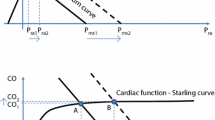Abstract
Purpose
The difference between mean systemic filling (Pmsf) and central venous pressure (CVP) is the venous return gradient (dVR). The aim of this study is to assess the significance of the Pmsf analogue (Pmsa) and the dVR during a fluid challenge.
Methods
We performed a prospective observational study in postsurgical patients. Patients were monitored with a central venous catheter, a LiDCO™plus and the Navigator™. A 250-ml intravenous fluid challenge was given over 5 min. A positive response to the fluid challenge was defined as either a stroke volume (SV) or cardiac output increase of greater than 10 %.
Results
A total of 101 fluid challenges were observed in 39 patients. In 43 events (42.6 %) the SV and CO increased by more than 10 %. Pmsa increased similarly during a fluid challenge in responders and non-responders (3.1 ± 1.9 vs. 3.1 ± 1.8, p = 0.9), whereas the dVR increased in responders (1.16 ± 0.8 vs. 0.2 ± 1, p < 0.001) as among non-responders CVP increased along with Pmsa (2.9 ± 1.7 vs. 3.1 ± 1.8, p = 0.15). Resistance to venous return did not change immediately after a fluid challenge. Heart performance (Eh) decreased significantly among non-responders (0.41 ± 0.15 vs. 0.34 ± 0.13, p < 0.001) whereas among responders it did not change when compared with baseline value (0.35 ± 0.15 vs. 0.34 ± 0.12, p = 0.15).
Conclusions
The changes in Pmsa and dVR measured at the bedside during a fluid challenge are consistent with the cardiovascular model described by Guyton.



Similar content being viewed by others
References
Patterson SW, Starling EH (1914) On the mechanical factors which determine the output of the ventricles. J Physiol 48(5):357–379
Hughes CG, Weavind L, Banerjee A, Mercaldo ND, Schildcrout JS, Pandharipande PP (2010) Intraoperative risk factors for acute respiratory distress syndrome in critically ill patients. Anesth Analg 111(2):464–467
Wiedemann HP, Wheeler AP, Bernard GR, Thompson BT, Hayden D, deBoisblanc B, Connors AF Jr, Hite RD, Harabin AL (2006) Comparison of two fluid-management strategies in acute lung injury. N Engl J Med 354(24):2564–2575
Huang SJ, Hong WC, Han YY, Chen YS, Wen CS, Tsai YS, Tu YK (2006) Clinical outcome of severe head injury using three different ICP and CPP protocol-driven therapies. J Clin Neurosci 13(8):818–822
Payen D, de Pont AC, Sakr Y, Spies C, Reinhart K, Vincent JL (2008) A positive fluid balance is associated with a worse outcome in patients with acute renal failure. Crit Care 12(3):R74
Bayliss WM, Starling EH (1894) Observations on venous pressures and their relationship to capillary pressures. J Physiol 16(3–4):159–318.7
Guyton AC (1968) Regulation of cardiac output. Anesthesiology 29(2):314–326
Guyton AC (1955) Determination of cardiac output by equating venous return curves with cardiac response curves. Physiol Rev 35(1):123–129
Guyton AC, Lindsey AW, Kaufmann BN (1955) Effect of mean circulatory filling pressure and other peripheral circulatory factors on cardiac output. Am J Physiol 180(3):463–468
Guyton AC, Lindsey AW, Kaufmann BN, Abernathy JB (1958) Effect of blood transfusion and hemorrhage on cardiac output and on the venous return curve. Am J Physiol 194(2):263–267
Maas JJ, Geerts BF, van den Berg PC, Pinsky MR, Jansen JR (2009) Assessment of venous return curve and mean systemic filling pressure in postoperative cardiac surgery patients. Crit Care Med 37(3):912–918
Anderson RM (1993) The gross physiology of the cardiovascular system. Racquet, Tucson
Parkin WG, Leaning MS (2008) Therapeutic control of the circulation. J Clin Monit Comput 22(6):391–400
Parkin G, Wright C, Bellomo R, Boyce N (1994) Use of a mean systemic filling pressure analogue during the closed-loop control of fluid replacement in continuous hemodiafiltration. J Crit Care 9(2):124–133
Maas JJ, Pinsky MR, Geerts BF, de Wilde RB, Jansen JR (2012) Estimation of mean systemic filling pressure in postoperative cardiac surgery patients with three methods. Intensive Care Med 38(9):1452–1460
Magder S (2005) How to use central venous pressure measurements. Curr Opin Crit Care 11(3):264–270
Lakhal K, Ehrmann S, Runge I, Benzekri-Lefevre D, Legras A, Dequin PF, Mercier E, Wolff M, Regnier B, Boulain T (2010) Central venous pressure measurements improve the accuracy of leg raising-induced change in pulse pressure to predict fluid responsiveness. Intensive Care Med 36(6):940–948
Cecconi M, Parsons AK, Rhodes A (2011) What is a fluid challenge? Curr Opin Crit Care 17(3):290–295
Vincent JL, Weil MH (2006) Fluid challenge revisited. Crit Care Med 34(5):1333–1337
Weil MH, Henning RJ (1979) New concepts in the diagnosis and fluid treatment of circulatory shock. Thirteenth annual Becton, Dickinson and Company Oscar Schwidetsky Memorial Lecture. Anesth Analg 58(2):124–132
Kumar A, Anel R, Bunnell E, Habet K, Zanotti S, Marshall S, Neumann A, Ali A, Cheang M, Kavinsky C, Parrillo JE (2004) Pulmonary artery occlusion pressure and central venous pressure fail to predict ventricular filling volume, cardiac performance, or the response to volume infusion in normal subjects. Crit Care Med 32(3):691–699
Osman D, Ridel C, Ray P, Monnet X, Anguel N, Richard C, Teboul JL (2007) Cardiac filling pressures are not appropriate to predict hemodynamic response to volume challenge. Crit Care Med 35(1):64–68
Figg KK, Nemergut EC (2009) Error in central venous pressure measurement. Anesth Analg 108(4):1209–1211
Author information
Authors and Affiliations
Corresponding author
Electronic supplementary material
Below is the link to the electronic supplementary material.
Rights and permissions
About this article
Cite this article
Cecconi, M., Aya, H.D., Geisen, M. et al. Changes in the mean systemic filling pressure during a fluid challenge in postsurgical intensive care patients. Intensive Care Med 39, 1299–1305 (2013). https://doi.org/10.1007/s00134-013-2928-6
Received:
Accepted:
Published:
Issue Date:
DOI: https://doi.org/10.1007/s00134-013-2928-6




